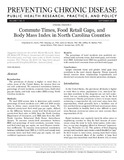Commute Times, Food Retail Gaps, and Body Mass Index in North Carolina Counties
Author
Jilcott Pitts, Stephanie Bell; Liu, Haiyong; Moore, Justin B.; Bethel, Jeffrey W.; Wilson, James; Ammerman, Alice S.
Abstract
Introduction
The prevalence of obesity is higher in rural than in urban areas of the United States, for reasons that are not well understood. We examined correlations between percentage of rural residents, commute times, food retail gap per capita, and body mass index (BMI) among North Carolina residents.
Methods
We used 2000 census data to determine each county's percentage of rural residents and 1990 and 2000 census data to obtain mean county-level commute times. We obtained county-level food retail gap per capita, defined as the difference between county-level food demand and county-level food sales in 2008, from the North Carolina Department of Commerce, and BMI data from the 2007 North Carolina Behavioral Risk Factor Surveillance System. To examine county-level associations between BMI and percentage of rural residents, commute times, and food retail gap per capita, we used Pearson correlation coefficients. To examine cross-sectional associations between individual-level BMI (n = 9,375) and county-level commute times and food retail gap per capita, we used multilevel regression models.
Results
The percentage of rural residents was positively correlated with commute times, food retail gaps, and county-level BMI. Individual-level BMI was positively associated with county-level commute times and food retail gaps.
Conclusions
Longer commute times and greater retail gaps may contribute to the rural obesity disparity. Future research should examine these relationships longitudinally and should test community-level obesity prevention strategies.
Date
2010-09
Citation:
APA:
Jilcott Pitts, Stephanie Bell, & Liu, Haiyong, & Moore, Justin B., & Bethel, Jeffrey W., & Wilson, James, & Ammerman, Alice S.. (September 2010).
Commute Times, Food Retail Gaps, and Body Mass Index in North Carolina Counties.
Preventing Chronic Disease,
7(5),
1-
10. Retrieved from
http://hdl.handle.net/10342/5841
MLA:
Jilcott Pitts, Stephanie Bell, and Liu, Haiyong, and Moore, Justin B., and Bethel, Jeffrey W., and Wilson, James, and Ammerman, Alice S..
"Commute Times, Food Retail Gaps, and Body Mass Index in North Carolina Counties". Preventing Chronic Disease.
7:5. (1-10),
September 2010.
June 29, 2024.
http://hdl.handle.net/10342/5841.
Chicago:
Jilcott Pitts, Stephanie Bell and Liu, Haiyong and Moore, Justin B. and Bethel, Jeffrey W. and Wilson, James and Ammerman, Alice S.,
"Commute Times, Food Retail Gaps, and Body Mass Index in North Carolina Counties," Preventing Chronic Disease 7, no.
5 (September 2010),
http://hdl.handle.net/10342/5841 (accessed
June 29, 2024).
AMA:
Jilcott Pitts, Stephanie Bell, Liu, Haiyong, Moore, Justin B., Bethel, Jeffrey W., Wilson, James, Ammerman, Alice S..
Commute Times, Food Retail Gaps, and Body Mass Index in North Carolina Counties. Preventing Chronic Disease.
September 2010;
7(5):
1-10.
http://hdl.handle.net/10342/5841. Accessed
June 29, 2024.
Collections

